By Asst. Prof. Dr. Nawat Watanachai
It is clouding of the eye caused by turbidity in the lens of the eye. There are many causes such as aging, infectious diseases in the mother's womb, accidents, both infectious and non-infectious inflammation, exposure to radiation, diseases caused by malnutrition, some genetic diseases. Like, many other metabolic diseases
Cataract It is an eye problem that has long affected the global community. The WHO estimates that 35-40 million people are blind worldwide, of six billion people, 45% of which are attributable to cataracts and its complications, especially in countries where there is no Very wealthy, located in a sunny area. (Familiar like Thailand?)
In addition, if it occurs in conjunction with some diseases, it may cause the lens to become opaque faster than normal, such as diabetes.
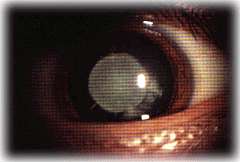
Symptom
- Dim Eyes In most cases, it will gradually dim, slowly, little by little. In addition to the accident or some other disease may dim quickly
- Decrease in contrast sensitivity (dark-light distinction) when in bright light or looking at lights at night
- myopic shift Is a change in the way that is more 'short-sighted', that is, farsightedness is less clear and nearsightedness is clearer. found in some types of cataracts
- monocular diplopia Is double vision as if there is more than one normal object while looking with one eye
- Eye pain and glaucoma This one is dangerous because it will fade over time. And fix it so that it can be difficult to see again or sometimes not at all
Treatment
Surgical Treatment :
1. Couching
It's an ancient method that no one has done. (India has been doing it for hundreds of years) will use a needle to poke. into the eye through the sclera to remove the cloudy lens from the original position into posterior eyeball which the patient will see not much clearly, andMust use glasses with lenses as large as Kanom Krok. to concentrate the light to focus instead of the lens that fell out This method has many complications. Nowadays, this method can still be found in some rural areas as well. (By doctors who do not have any degrees – as far as I have seen, some of them charge more expensive than conventional medicine. Currently in a government hospital, but in the end had to come to the hospital to solve complications together until now)
2. Intracapsular cataract extraction with/without intraocular lens implantation
This one was popular in modern medicine more than ten years ago. is surgery into the eyeball and pull out the whole lens and then insert an artificial lens instead or not and suture the wound This will reduce the complications caused by the lens that remain in the couching process, but there are still many side effects. Currently, almost no one does. Except in some patients such as Patients whose lens adhesion membrane is loose or torn, or those who have had a serious impact on the eye only as pictured below
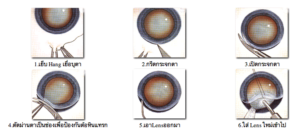
3. Extracapsular cataract extraction with/without intraocular lens implantation
Popular nowadays It is an incision into the eyeball. Pierce the lens hood to remove the cloudy lens completely. with the remaining lens cover and insert the artificial lens into the lens pouch and then suture the wound which will be safer during surgery And there are much fewer complications later. Currently popular to do this method. In cases where the lens is hard and opaque But the trend has been steadily declining.
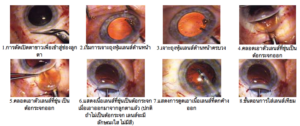
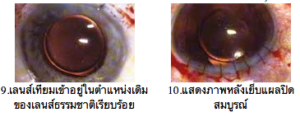
4. Phacoemulsification and aspiration with/without intraocular lens implantation
This method is becoming more and more popular nowadays. It is a surgery with a smaller incision than method 2.2, 2.3. The incision made in the eye may be less than half a centimeter. and will pierce the front lens pouch and using high-frequency sound waves to break up the lens into small pieces Then suck it out later (other methods are surgery to remove a single large piece of the lens, so the size of the incision is much larger than this method) and then insert an artificial lens and may be sutured or not sutured. depending on the size of the wound This method is even more secure. and are becoming more and more popular Currently doing widely in hospital centers. and a big nurse disease with tools (small hospital including the hospital Many provinces still do not have this tool to use. But in big provinces like Bangkok, there are probably dozens)
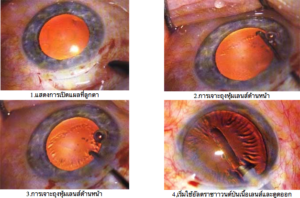
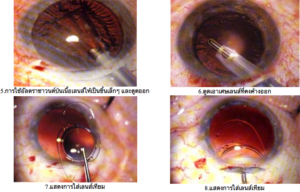
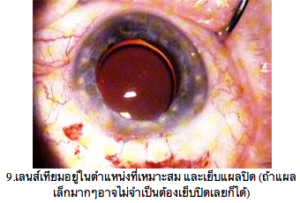
5. Other
May help to see in other ways, such as using eyeglasses. To correct short-sightedness / long-sightedness / astigmatism without directly correcting cataracts because of the blurry vision of each of us May come from many factors together, such as having cataracts with myopia, etc. If you still don't want to have surgery or inoperable for any reason or condition but want to see more clearly may use glasses to correct myopia first And about cataracts, let's talk later. which in the long run When cataracts become more cloudy must come to treat each other with cataracts anyway
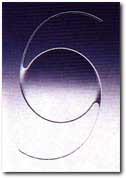
Artificial lens (IOL image): This is a purpose-built synthetic device. To work as a replacement for the natural lens in our eyes that is cloudy and needs to be removed. It serves to concentrate light to focus the image on the retina. There are dozens of lenses. type sold in the market Each species has its own unique properties. which the choice of any type depending on the patient And the consideration of the doctor who plans the treatment for me
Future Trend
-
Are hoping that there will be drops or medications that cause cloudy lenses cleared up by itself in every patient without surgery But it's still a long way (very)
Other methods have been used. Most of them are being studied, for example, using a laser to disintegrate the cloudy lens, cataracts, and then aspirate the disintegrated lens again.
